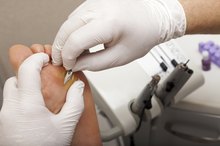How to Trim Warts
Warts -- small, rough growths that often affect the hands and feet -- can be difficult to treat. Viruses cause warts, so just cutting off a wart won't cure it. Removing the top layer of a wart by trimming off the dead skin can make it easier for medicine to penetrate and treat the infection. This is best done by medical personnel in an office, not at home. You can use over-the-counter medications called keratolytics that dissolve the dead layer safely at home. See your doctor to receive effective treatment for warts.
Your doctor can trim the top of a wart or totally remove it in the office, using sterile equipment to reduce your chances of developing an infection. You still need follow-up medication to kill the virus after this treatment. Doctors can trim a wart with a very tiny sterile blade, or they can numb the skin with a local anesthetic and cut deep enough to remove the wart. Removing the wart allows medication to treat the virus by penetrating more deeply into the skin.
Alternately, your doctor can destroy the top layer of the wart by applying liquid nitrogen -- a much stronger application than those you can buy over-the-counter. She also can apply acids or products that cause cell death to the top of the wart. Another way to get rid of the wart is to inject substances that are toxic to the virus or that cause the body to “wake up" and recognize the infection and attack it. Creams that help the immune system recognize the wart and destroy also have benefit.
Warts usually require follow-up treatment to destroy the virus even after trimming or removal. Ridding yourself of warts may take several office treatments plus applying creams or other treatments at home between visits. Warts on the hands and feet can take many sessions to clear. Trying to cure a wart yourself may be ineffective and result in an increase in the size of the wart.
Related Articles
References
- InformedHealth.org. Warts: Overview. Cologne, Germany: Institute for Quality and Efficiency in Health Care (IQWiG). Updated November 7, 2019.
- InformedHealth.org. What are the treatment options for warts? Cologne, Germany: Institute for Quality and Efficiency in Health Care (IQWiG). Updated November 7, 2019.
- Al Aboud AM, Nigam PK. Wart (Plantar, Verruca Vulgaris, Verrucae). Treasure Island, FL: StatPearls Publishing. Updated September 27, 2019.
- Liu J, Li H, Yang F, et al. Epidemiology and Clinical Profile of Cutaneous Warts in Chinese College Students: A Cross-Sectional and Follow-Up Study. Sci Rep. 2018;8(1):15450. doi:10.1038/s41598-018-33511-x
- Goldman RD. Duct tape for warts in children: Should nature take its course?. Can Fam Physician. 2019;65(5):337-338.
- Cockayne S, Hewitt C, Hicks K, et al. Cryotherapy versus salicylic acid for the treatment of plantar warts (verrucae): a randomised controlled trial. BMJ. 2011;342:d3271. doi:10.1136/bmj.d3271
- Baker DA, Ferris DG, Martens MG, et al. Imiquimod 3.75% cream applied daily to treat anogenital warts: combined results from women in two randomized, placebo-controlled studies. Infect Dis Obstet Gynecol. 2011;2011:806105. doi:10.1155/2011/806105
- Gaston A, Garry RF. Topical vitamin A treatment of recalcitrant common warts. Virol J. 2012;9:21. doi:10.1186/1743-422X-9-21
- Walczuk I, Eertmans F, Rossel B, et al. Efficacy and safety of three cryotherapy devices for wart treatment: A randomized, controlled, investigator-blinded, comparative study. Dermatol Ther (Heidelb). 2018;8(2):203-16. doi:10.1007/s13555-017-0210-5
- Dalimunthe DA, Siregar R, Tanjung C. Comparative clinical efficacy between electrodesiccation with curettage and application of 80% phenol solution in treatment of common warts. Open Access Maced J Med Sci. 2018;6(2):326-9. doi:10.3889/oamjms.2018.074
- Chauhan PS, Mahajan VK, Mehta KS, Rawat R, Sharma V. The efficacy and safety of intralesional immunotherapy with measles, mumps, rubella virus vaccine for the treatment of common warts in adults. Indian Dermatol Online J. 2019;10(1):19-26. doi:10.4103/idoj.IDOJ_142_18
- Nofal A, Elkot R, Nofal E, Mazen M. Combination therapy versus monotherapy in the treatment of recalcitrant warts: A clinical and immunological study. J Cosmet Dermatol. 2018;2018;12848. doi:10.1111/jocd.12848
- Raghukumar S, Ravikumar BC, Vinay KN, et al. Intralesional vitamin D injection in the treatment of recalcitrant warts: A novel proposition. J Cutan Med Surg. 2017;21(4):320-4. doi:10.1177/1203475417704180
Resources
Writer Bio
Dr. Tanya Kormeili is a nationally recognized, board-certified dermatologist. She is a clinical professor in dermatology at the UCLA School of Medicine, as well as Cedars-Sinai Medical Center. Dr. Kormeili has appeared on national television, has been featured in "Dermatology Times" and has been quoted extensively in the media as an expert.








